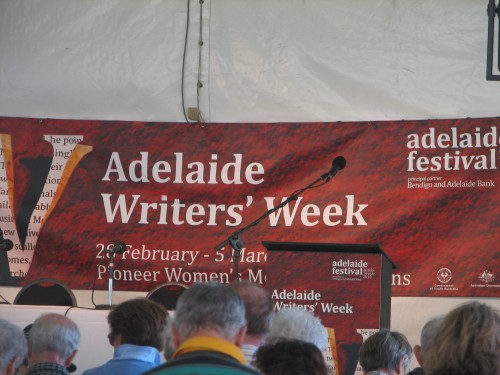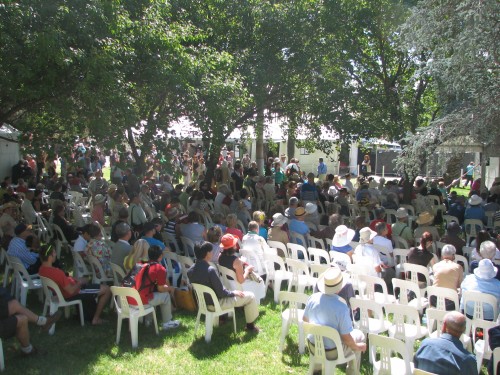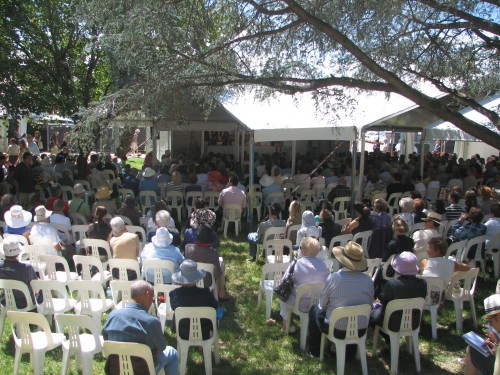How does this happen? Confessions of a book lover.
The biennial Adelaide Festival of Arts starts today. This feast of cultural events is now a well established event in South Australia, celebrating 50 years of festivals this year. It has maintained a world class standard for festivals since its inception. This week there have been political promises to make it an annual event – we have a state election here in 3 weeks’ time.
Writers’ Week
A very prominent and popular part of the Adelaide Festival of Arts is Writers’ Week, starting tomorrow. Several dozen leading Australian and International writers descend on Adelaide for this festival. Several large marquees are set up in the beautiful parklands and the writers are given centre stage for a whole week. Most sessions are free events for the reading and writing public, a rare thing these days. Book launches are also a prominent feature of the week, along with the announcement of a raft of awards.
Programme Guide
I plan to attend a number of sessions next week so during the week I wandered into a leading bookshop in Adelaide to buy the programme guide. The price was $7 and I thought that wouldn’t break the bank or drain the wallet too much.
How come then I come out of the bookshop with six books in a bag?
Those wonderful novels – some in hardback – were sitting there on the bargain tables quietly whispering my name and begging to be taken to a good home. I couldn’t resist.
As part of this confession, and to atone for my misdeeds, I’ll read those books over coming weeks and then review them here on this blog. It’s the least I can do.
Good reading.
Good writing.
To read more about my impressions of the Adelaide Writers’ Week click here.
How to write a pantoum poem
Yesterday I wrote about how I write poetry.
It’s a simple formula and one that usually works for me. My only regret is that I far too often either don’t have the time to devote to poetry – or I don’t make the time. As a prize winning poet I know I should be writing more.
The regular monthly poetry writers’ group I attend is one thing that keeps me writing poetry on a regular basis. Each month we set a writing challenge for the following meeting. Some of the challenges last year were really inspiring, and hearing everyone’s take on the one challenge is very interesting. The critiquing of each poem is also valuable. There are many benefits to belonging to a writers’ group.
In this coming month we were set the task of writing a pantoum on the theme of obsession. Now, I’ve never written a pantoum and have resisted doing so until now. I thought it was too hard, too complex. I was wrong. A few days ago I managed to write a pantoum called Obsessed by Sonnets. That’s right – I wrote a pantoum about writing sonnets! Go figure.
What is a pantoum?
Good question.
It is a poem of Malay origins and has undergone a few adaptations on its way into English poetry circles via the French. Essentially it consists of the following:
- A set of four lined stanzas (quatrains) – anything from three stanzas and up.
- It has a simple abab rhyming pattern throughout.
- It is often metred but I believe that this is not a strict rule. However, metred poems always sound wonderful when read aloud.
- Lines are repeated in a strict pattern.
- Lines 2 and 4 of the each stanza become 1st and 3rd lines of the next stanza. This is repeated throughout the poem until the last stanza.
- In the last stanza, the so far unrepeated 1st and 3rd lines of the first stanza become the 2nd and 4th lines – but in reverse order. This means the poem comes full circle and the last line is a repeat of the first line of the poem. This gives the whole work a very satisfying feel to it.
I’ll now be very brave and publish here a pantoum I wrote this afternoon. Note that a few words here and there have been changed to make grammatical or narrative sense.
What is a pantoum?
A pantoum is challenging to write,
It’s a poem of elegance and grace.
With stanzas of four lines – that’s right –
And a rhyming pattern to face.
It’s a poem of elegance and grace,
With quatrains for stanzas I’m sure,
And a rhyming pattern to face,
Not to mention a message that’s pure.
With quatrains for stanzas I’m sure,
And a metre so regular too,
I won’t mention my message so pure,
For I’m planning to entertain you.
It’s my metre that’s regular too,
With stanzas of four lines – that’s right –
For I’m planning to entertain you
With a pantoum that’s challenging to write.
All rights reserved.
Copyright 2010 Trevor Hampel.
How I write poetry
Writing poetry has been a love of mine from my very early years. I was barely a teenager before I started writing poetry seriously. Back then it was a haphazard affair with no real plan or purpose. Most were scribbled furiously on to any convenient scarp of paper and stored ungraciously in boxes or drawers.
In my 20s I started to be a little more methodical and I started using a manual typewriter to make neat, readable copies of them. These were stored in folders. Fortunately I usually date each poem, so it was relatively easy to store them all in chronological order of composition.
Four decades later it is a different matter. I am far more deliberate in my approach to writing poetry. Several of the units of course work for my Master of Arts in Creative Writing have involved writing poetry. Being an active member of the university’s writers’ groups has also given a boost to my poetry. Some of the assignments have been very challenging. Before starting the course I had never attempted to write a sonnet, for example. Now I’ve written prize winning sonnets and love the form. In the last few years I also started getting some publishing success with my poetry. It’s early days in my career as a poet, but the signs are encouraging.
How I write a poem
- Most of the time I use a pencil. There is something wonderfully tactile about using a pencil on paper. It certainly helps the creative process when writing a poem. By way of contrast I always write prose on the computer keyboard. I can’t ever remember writing a poem on the keyboard.
- I usually write the first draft of a new poem in my writing notebook first. This is a spiral bound A5 size notebook with hard covers.
- I decide on the topic (unless it has been decided by the writers’ group) and play around with the idea, jotting down a few words, phrases and ideas.
- I think about what form the poem should take to be most effective: sonnet, blank verse, haiku and so on. The form often determines the rhyming scheme (if any) and metre that best suits the topic.
- I always try to have a strong opening line and will experiment until I can settle on one. The whole poem often grows from that good first line. It sets the tone.
- During the writing I will have many false starts, words, phrases and even whole stanzas that never make the final work. My notebook can end up quite a mess, with many sections crossed out, arrows leading everywhere as I rearrange the work.
- Reading the poem out aloud is an important part of my method; it has to sound right, and the metre has to work.
- After much editing, rewriting and correcting, I finally turn to the computer and compose it on screen. I will try several different formatting ideas before settling on something that looks pleasing to the eye and is easy to read.
- I will reread the poem aloud many more times, making minor corrections on screen as needed.
- I print out a copy and file it away in a poetry folder. It may be many months before I come back to that poem, do a few more minor alterations and submit it to a publisher.
Good writing.




